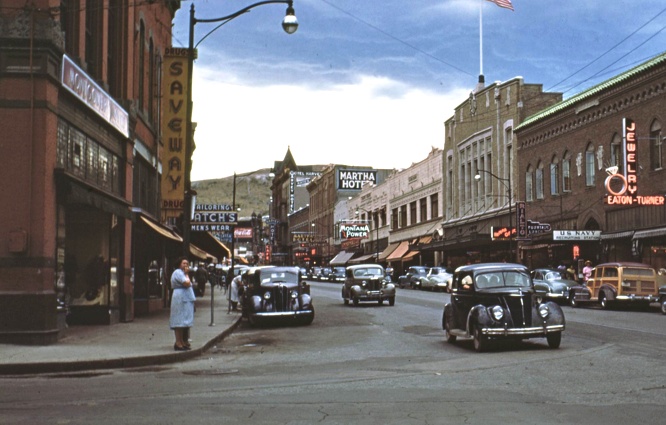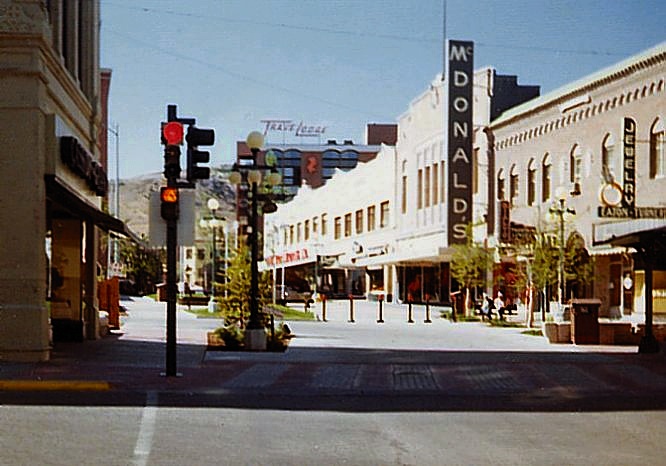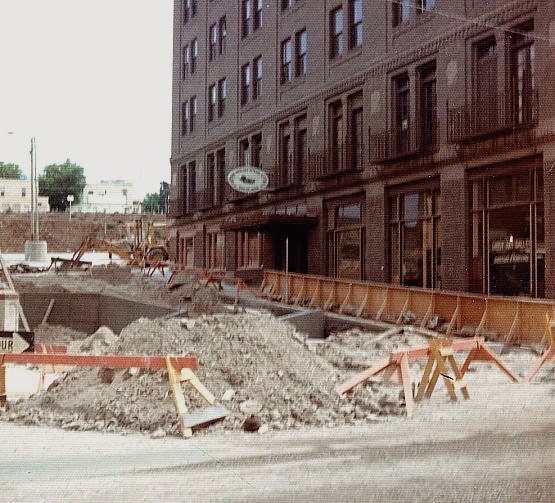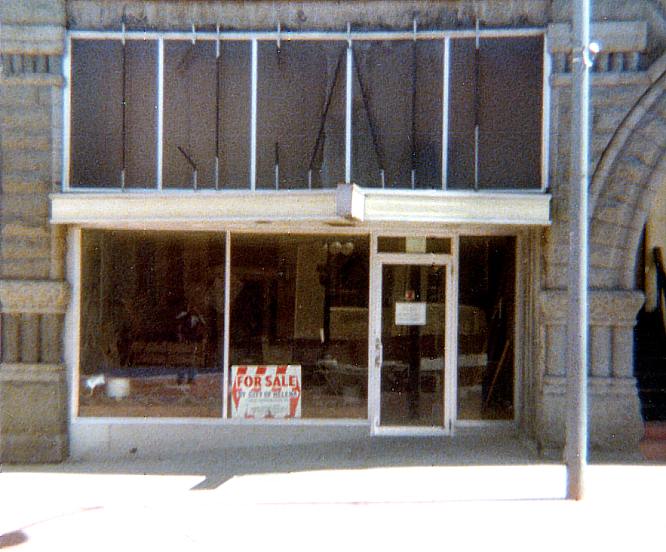Walking Mall 1970s (original) (raw)
 |
 |
 |
 |
|---|---|---|---|
 |
 |
 |
 |
 |
 |
 |
 |
 |
 |
 |
 |
 |
 |
 |
 |
 |
 |
 |
 |
 |
 |
 |
 |
 |

What Happened to Main Street?

1954

1978
During the 1960s and 70s, creating vehicle-free pedestrian malls in older downtown areas was trendy in U.S. urban planning circles. The idea was to offer a novel alternative to compete with the new suburban malls that were taking business away from the older centers. Indeed, some 200 pedestrian malls were built around the country during that period.
The concept, however, has proven to be an expensive and almost universal failure. Today, all but about 30 of those 200 malls have been ripped up, and traffic - in varying degrees - has been allowed back into the older commercial areas. As this article in the New York Times points out, the results have been very positive.
Helenans have argued for years about modifying the Main Street mall to accomodate traffic, but as of this writing, Helena is one of a dwindling handful of communities in the U.S. still clinging to this outmoded idea.
Building Helena's mall required the closing of Main Street to motor vehicle traffic from about State St. north to Sixth Ave. The street was re-paved for pedestrian use, a fake stream was plumbed-in on a portion of the mall, carved stone architectural elements from demolished Victorian buildings were laid about, several new sculptures were placed, and landscaping was done.
The mall was developed in two phases from 1973 to 1977. Phase I was from the south end of Main to Broadway, Phase II from Broadway north to Sixth Ave. The total cost was 54millioninpublicandprivatefunds,whichtranslatestoabout54 million in public and private funds, which translates to about 54millioninpublicandprivatefunds,whichtranslatestoabout200 million in today's dollars -- and you can't even drive on it.
Most of these early photos of the Urban Renewal Program's pedestrian mall and adjacent areas were taken in the 1970s by Virgie Millegan Baird (1921-1999); photos by other contributors are so noted.
Destruction on 6th Avenue - Former Site of the Electric Block

Cruse Avenue Under Construction

Grand St. once crossed here. The building on the left once served as the Methodist Episcopal Church.
Construction on the Former Site of Grand St.

The 1913 Placer Hotel is on the right.
The Arcade Building Under Construction

The Atlas Block and Adjacent Buildings, Main at Broadway, Winter 1973-74

PHOTO BY WALLACE "SKIP" MILLEGAN JR. (1951-1982) • COLLECTION OF KENNON BAIRD
Old KCAP Studios in the Atlas Block, ca. 1976

Vacant storefront in the Atlas Block. This space was once the studios of KCAP radio. Above the door can be seen the ghost of the KCAP sign. For more about KCAP, click here.
 |
Click the Audio Link to hear a short 1965 KCAP on-air clip. Courtesy of Frank Cuta. Thanks, Frank! |
|---|

The hideous "Prospector Fountain" by Lyndon Fayne Pomeroy, Last Chance Gulch at Broadway. It was created and installed in 1974, during Urban Renewal, at a cost of 10,000−−about10,000 -- about 10,000−−about45,000 in today's money. The steel assemblage was originally kinetic; the sluice box would fill with water and empty via gravity about four times per minute. The box was eventually welded in place following complaints about the incessant clanging.
In 1976, city commissioners turned down an Urban Renewal proposal for an additional sculpture by Pomeroy, this time of the Four Georgians on horseback...

In some ways, the most positive legacy of Urban Renewal is what it didn't do. This grotesquery would have cost 40,000−−about40,000 -- about 40,000−−about220,000 in 2019 dollars.
"The Mountain Fountain" Sculpture
by Theodore J. Waddell
Now on the North Side of the Federal Reserve Bank

"The Mountain Fountain", also referred to in print as "The Mount Helena Fountain" and "The Mountain Park Fountain", was installed on the Walking Mall in 1977 at a cost of about $34,000 in today's money. It is the work of sculptor and painter Theodore J. Waddell.

The fountain proved to be unpopular, and was removed from the mall sometime after 1983. It is now on the north side of the Helena Branch of the Federal Reserve Bank, just west of Front Street (thanks to Annah Smith and "Donna" for the heads-up on the fountain's current location).
"The Mountain Fountain", 2009
North Side of the Helena Branch of the Federal Reserve Bank
Photos by Annah Smith



The 1890 Boston Block and a portion of Dorothy's Rooms, winter 1973-74

PHOTO BY WALLACE "SKIP" MILLEGAN JR. (1951-1982) • COLLECTION OF KENNON BAIRD
Walking Mall, Looking South Near Broadway, ca. 1975

Restored Trolley, ca. 1975

Walking Mall, Looking North

The 1888 Colwell Building is on the left.
Vacant Storefront in the Colwell Building

Weggenman's Market occupied this space for decades...

Landscaping on the South End of the Mall

The faux stream burbles along its concrete course.
Site of the City-County Library and Federal Building


COURTESY OF DAVE THOMAS
The site a few years later...

Notice how the fortress-like Federal Building and the bland library spoil a perfectly nice view.
The new lampposts are similar in design to those installed in Helena during the1920s. The Independent Record reported in 1976 that these lamps, and other new mall fixtures, had been vandalized to the tune of 3,000(about3,000 (about 3,000(about11,000 today) in just two years.
Looking West on Broadway from the Mall

The grand stage of the Marlow Theatre once occupied this site. The Gaslight Cinema is on the left.
Cruse Ave. Pedestrian Underpass

Prominent on the left is the 1889 Bluestone House.
The Bluestone House and Fire Tower, September 1970

PHOTO BY ARNIE ROGERS • COURTESY OF PATRICIA ROGERS GLISSON
CLICK ON IMAGE FOR A BIG VIEW IN A NEW WINDOW
This handsome photo by the late Arnie Rogers shows part of the old city just months before it was razed during the Urban Renwal project. The Bluestone House and Fire Tower still stand.
The Bluestone House and Fire Tower, Winter 1973-74

PHOTO BY WALLACE "SKIP" MILLEGAN JR. (1951-1982) • COLLECTION OF KENNON BAIRD
The Bluestone House and Fire Tower, mid-1970's

COURTESY OF DAVE THOMAS

 |
 |
 |
 |
|---|---|---|---|
 |
 |
 |
 |
 |
 |
 |
 |
 |
 |
 |
 |
 |
 |
 |
 |
 |
 |
 |
 |
 |
 |
 |
 |
 |